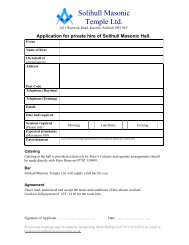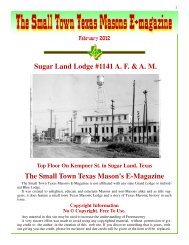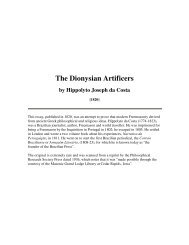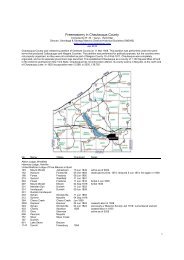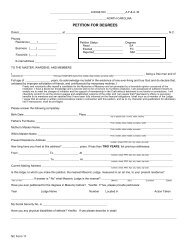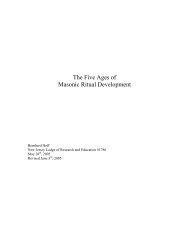Entered apprentice info - MasterMason.com
Entered apprentice info - MasterMason.com
Entered apprentice info - MasterMason.com
Create successful ePaper yourself
Turn your PDF publications into a flip-book with our unique Google optimized e-Paper software.
Mason. If he is properly instructed, he will rest one point in the innermost center of his being, and<br />
with the other draw a circle beyond which he will not go, until he is ready and able to go farther.<br />
Against the littleness of his knowledge he will set the depth of his desire to know, against the<br />
brevity of his earthly life the reach of his spiritual hope. Within a wise limit he will live and labor<br />
and grow, and when he reaches the outer rim of the circle he will draw another, and attain to a<br />
full-orbed life, balance, beautiful, and finely poised. No wise man dare forget the maxim "In<br />
nothing too much," for there are situations where a word too much, a step too far, means disaster.<br />
If he has a quick tongue, a hot temper, a dark mood, he will apply the Compasses, shut his<br />
weakness within the circle of his strength, and control it.<br />
Strangely enough, even a virtue, if unrestrained and left to itself, may actually be<strong>com</strong>e a vice.<br />
Praise, if pushed too far, be<strong>com</strong>es flattery. Love often ends in a soft sentimentalism, flabby and<br />
foolish. Faith, if carried to the extreme by the will to believe, ends in over-belief and superstition.<br />
It is the Compasses that help us to keep our balance, in obedience to the other Greek maxim:<br />
"Think as a mortal" - that is, remember the limits of human thought. An old mystic said that God is<br />
a circle whose center is everywhere, and its circumference nowhere. But such an idea is all a blur<br />
Our minds can neither grasp nor hold it. Even in our thought about God we must draw a circle<br />
enclosing so much of His Nature as we can grasp and realize, enlarging the circle as our<br />
experience and thought and vision expand. Many a man loses all truth in his impatient effort to<br />
reach final truth. It is the man who fancies that he has found the only truth, the whole truth, and<br />
nothing but the truth, and who seeks to impose his dogma upon others, who be<strong>com</strong>es the bigot,<br />
the fanatic, the persecutor. Here, too, we must apply the Compasses, if we would have our faith<br />
fulfill itself in fellowship. Now we know in part - a small part, it may be, but it is real as far at it<br />
goes - though it be as one who sees in a glass darkly. The promise is that if we are worthy and<br />
well qualified, we shall see God face to face and know ever as we are known. But God is so great,<br />
so far beyond my mind and yours, that if we are to know him truly, we must know Him Together, in<br />
fellowship and fraternity. And so the Poet-Mason was right when he wrote: "He drew a circle that<br />
shut me out, Heretic, rebel, a thing to flout; But love and I had the wit to win, We drew a circle<br />
that took him in."<br />
SHORT TALK BULLETIN - Vol.V November, 1927 No.11<br />
THE LAMBSKIN APRON<br />
by: Unknown<br />
In Masonic symbolism the Lambskin Apron holds precedence. It is the initial gift of Freemasonry to a candidate,<br />
and at the end of life's pilgrimage it is reverently placed on his mortal remains and buried with his body in the<br />
grave.<br />
Above all other symbols, the Lambskin Apron is the distinguishing badge of a Mason. It is celebrated in poetry<br />
and prose and has been the subject of much fanciful speculation. Some Masonic writers have contended that<br />
initiation is analogous to birth, or our advent from prenatal darkness into the light of human fellowship, moral<br />
truth and spiritual faith. Much ancient lore has been adduced in an effort to show that the Lambskin Apron<br />
typifies regeneration, or a new life, and this thought of resurrection may be the cause of its internment with the<br />
body of a deceased brother. At least it will serve until a better reason is advanced for this peculiar custom in the<br />
Masonic burial service. The association of the lamb with redemption and being born again is expressed by John,<br />
the Apocalyptic Seer, who had a vision on the Isle of Patmos, and beheld the purified and redeemed "Of All<br />
Nations, Kindreds, People and Tongues. " Of them it was said, "These are they which came out of great<br />
tribulation and have washed their robes and made them white in the blood of the Lamb. "<br />
15



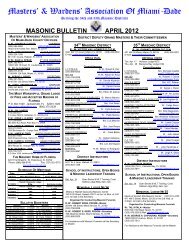
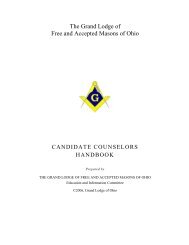
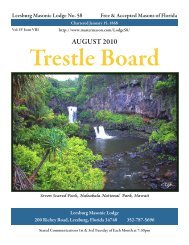

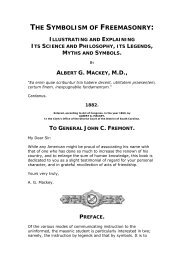

![Junior Grand Warden Views [2005-2] - MasterMason.com](https://img.yumpu.com/36303049/1/190x245/junior-grand-warden-views-2005-2-mastermasoncom.jpg?quality=85)
